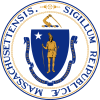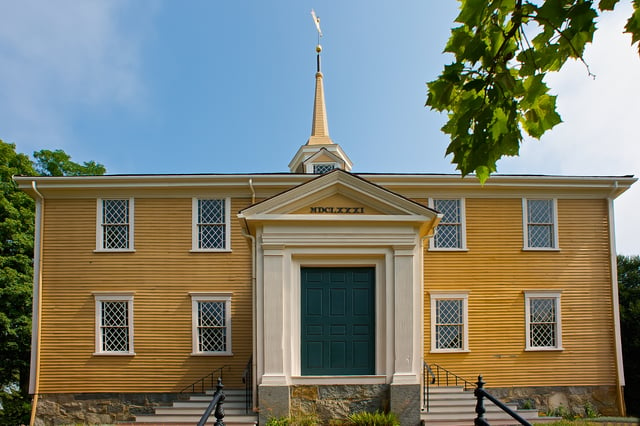Massachusetts

Massachusetts

Massachusetts | |
|---|---|
| Commonwealth of Massachusetts | |
| Nickname(s): | |
| Motto(s): Ense petit placidam sub libertate quietem (Latin) By the sword we seek peace, but peace only under liberty | |
| Anthem: All Hail to Massachusetts | |
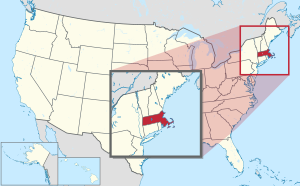 Map of the United States with Massachusetts highlighted | |
| Country | United States |
| Before statehood | Province of Massachusetts Bay |
| Admitted to the Union | February 6, 1788 (6th) |
| Capital (and largest city) | Boston |
| Largest metro | Greater Boston |
| Government | |
| • Governor | Charlie Baker (R) |
| • Lieutenant Governor | Karyn Polito (R) |
| Area | |
| • Total | 10,565[2] sq mi (27,337 km2) |
| • Land | 7,840 sq mi (20,306 km2) |
| • Water | 2,715 sq mi (7,032 km2) 26.1% |
| Area rank | 44th |
| Dimensions | |
| • Length | 300 mi (174 km) |
| • Width | 183 mi (295 km) |
| Elevation | 500 ft (150 m) |
| Highest elevation | 3,489 ft (1,063.4 m) |
| Lowest elevation (Atlantic Ocean) | 0 ft (0 m) |
| Population | |
| • Total | 6,902,149 (2,018) |
| • Rank | 15th |
| • Density | 840/sq mi (324/km2) |
| • Density rank | 3rd |
| • Median household income | $77,385[5] |
| • Income rank | 5th |
| Demonym(s) | Bay Stater (official)[6] Massachusite (traditional)[7][8] |
| Language | |
| • Official language | English[9] |
| • Spoken language |
|
| Time zone | UTC-05:00 (Eastern) |
| • Summer (DST) | UTC-04:00 (EDT) |
| USPS abbreviation | MA |
| ISO 3166 code | US-MA |
| Trad. abbreviation | Mass. |
| Legislature | General Court |
| • Upper house | Senate |
| • Lower house | House of Representatives |
| U.S. senators | Elizabeth Warren (D) Ed Markey (D) |
| U.S. House delegation | 9 Democrats (list) |
| Latitude | 41° 14′ N to 42° 53′ N |
| Longitude | 69° 56′ W to 73° 30′ W |
| Website | www.mass.gov [383] |
Massachusetts (/ˌmæsəˈtʃuːsɪts/ (listen), /-zɪts/), officially the Commonwealth of Massachusetts, is the most populous state in the New England region of the northeastern United States. It borders on the Atlantic Ocean to the east, the states of Connecticut and Rhode Island to the south, New Hampshire and Vermont to the north, and New York to the west. The state is named after the Massachusett tribe, which once inhabited the east side of the area, and is one of the original thirteen states. The capital of Massachusetts is Boston, which is also the most populous city in New England. Over 80% of the population of Massachusetts lives in the Greater Boston metropolitan area, a region influential upon American history, academia, and industry.[41] Originally dependent on agriculture, fishing and trade,[42] Massachusetts was transformed into a manufacturing center during the Industrial Revolution.[43] During the 20th century, Massachusetts's economy shifted from manufacturing to services.[44] Modern Massachusetts is a global leader in biotechnology, engineering, higher education, finance, and maritime trade.[45]
Plymouth was the site of the second colony in New England after Popham Colony in 1607 in what is now Maine.[46] Plymouth was founded in 1620 by the Pilgrims, passengers of the Mayflower. In 1692, the town of Salem and surrounding areas experienced one of America's most infamous cases of mass hysteria, the Salem witch trials.[47] In 1777, General Henry Knox founded the Springfield Armory, which during the Industrial Revolution catalyzed numerous important technological advances, including interchangeable parts.[48] In 1786, Shays' Rebellion, a populist revolt led by disaffected American Revolutionary War veterans, influenced the United States Constitutional Convention.[49] In the 18th century, the Protestant First Great Awakening, which swept the Atlantic World, originated from the pulpit of Northampton preacher Jonathan Edwards.[50] In the late 18th century, Boston became known as the "Cradle of Liberty"[51] for the agitation there that led to the American Revolution.
The entire Commonwealth of Massachusetts has played a powerful commercial and cultural role in the history of the United States. Before the American Civil War, Massachusetts was a center for the abolitionist, temperance,[52] and transcendentalist[53] movements.[54] In the late 19th century, the sports of basketball and volleyball were invented in the western Massachusetts cities of Springfield and Holyoke, respectively.[55][56] In 2004, Massachusetts became the first U.S. state to legally recognize same-sex marriage as a result of the decision in Goodridge v. Department of Public Health by the Massachusetts Supreme Judicial Court.[57] Many prominent American political dynasties have hailed from the state, including the Adams and Kennedy families. Harvard University in Cambridge is the oldest institution of higher learning in the United States,[58] with the largest financial endowment of any university,[59] and Harvard Law School has educated a contemporaneous majority of Justices of the Supreme Court of the United States.[60] Kendall Square in Cambridge has been called "the most innovative square mile on the planet", in reference to the high concentration of entrepreneurial start-ups and quality of innovation which have emerged in the vicinity of the square since 2010.[61][62] Both Harvard University and the Massachusetts Institute of Technology, also in Cambridge, have been ranked among the most highly regarded academic institutions in the world.[63] Massachusetts' public-school students place among the top tier in the world in academic performance,[64] and the state has been ranked as one of the top states in the United States for citizens to live in, as well as one of the most expensive.[65]
Massachusetts | |
|---|---|
| Commonwealth of Massachusetts | |
| Nickname(s): | |
| Motto(s): Ense petit placidam sub libertate quietem (Latin) By the sword we seek peace, but peace only under liberty | |
| Anthem: All Hail to Massachusetts | |
 Map of the United States with Massachusetts highlighted | |
| Country | United States |
| Before statehood | Province of Massachusetts Bay |
| Admitted to the Union | February 6, 1788 (6th) |
| Capital (and largest city) | Boston |
| Largest metro | Greater Boston |
| Government | |
| • Governor | Charlie Baker (R) |
| • Lieutenant Governor | Karyn Polito (R) |
| Area | |
| • Total | 10,565[2] sq mi (27,337 km2) |
| • Land | 7,840 sq mi (20,306 km2) |
| • Water | 2,715 sq mi (7,032 km2) 26.1% |
| Area rank | 44th |
| Dimensions | |
| • Length | 300 mi (174 km) |
| • Width | 183 mi (295 km) |
| Elevation | 500 ft (150 m) |
| Highest elevation | 3,489 ft (1,063.4 m) |
| Lowest elevation (Atlantic Ocean) | 0 ft (0 m) |
| Population | |
| • Total | 6,902,149 (2,018) |
| • Rank | 15th |
| • Density | 840/sq mi (324/km2) |
| • Density rank | 3rd |
| • Median household income | $77,385[5] |
| • Income rank | 5th |
| Demonym(s) | Bay Stater (official)[6] Massachusite (traditional)[7][8] |
| Language | |
| • Official language | English[9] |
| • Spoken language |
|
| Time zone | UTC-05:00 (Eastern) |
| • Summer (DST) | UTC-04:00 (EDT) |
| USPS abbreviation | MA |
| ISO 3166 code | US-MA |
| Trad. abbreviation | Mass. |
| Legislature | General Court |
| • Upper house | Senate |
| • Lower house | House of Representatives |
| U.S. senators | Elizabeth Warren (D) Ed Markey (D) |
| U.S. House delegation | 9 Democrats (list) |
| Latitude | 41° 14′ N to 42° 53′ N |
| Longitude | 69° 56′ W to 73° 30′ W |
| Website | www.mass.gov [383] |
Etymology
The Massachusetts Bay Colony was named after the indigenous population, the Massachusett, likely derived from a Wôpanâak word muswach8sut, segmented as mus(ây) "big" + wach8 "mountain" + -s "diminutive" + -ut "locative" (the '8' in these words refers to the 'oo' sound according to the Wôpanâak orthographic chart).[66] It has been translated as "near the great hill",[67] "by the blue hills", "at the little big hill", or "at the range of hills", referring to the Blue Hills, or in particular the Great Blue Hill which is located on the boundary of Milton and Canton.[68][69] Alternatively, Massachusett has been represented as Moswetuset—from the name of the Moswetuset Hummock (meaning "hill shaped like an arrowhead") in Quincy, where Plymouth Colony commander Myles Standish, hired English military officer, and Squanto, part of the now disappeared Patuxet band of the Wampanoag peoples, met Chief Chickatawbut in 1621.[70][71]
The official name of the state is the "Commonwealth of Massachusetts".[72] While this designation is part of the state's official name, it has no practical implications.[73] Massachusetts has the same position and powers within the United States as other states.[74] It may have been chosen by John Adams for the second draft of the Massachusetts Constitution because unlike the word "state", "commonwealth" at the time had the connotation of a republic, in contrast to the monarchy the former American colonies were fighting against. (The "State of Massachusetts Bay" was in the first draft that had been rejected by the legislature.)[75]
History
Pre-colonization
Massachusetts was originally inhabited by tribes of the Algonquian language family such as the Wampanoag, Narragansett, Nipmuc, Pocomtuc, Mahican, and Massachusett.[76][77] While cultivation of crops like squash and corn supplemented their diets, these tribes were generally dependent on hunting, gathering and fishing for most of their food.[76] Villages consisted of lodges called wigwams as well as longhouses,[77] and tribes were led by male or female elders known as sachems.[78]
Colonial period
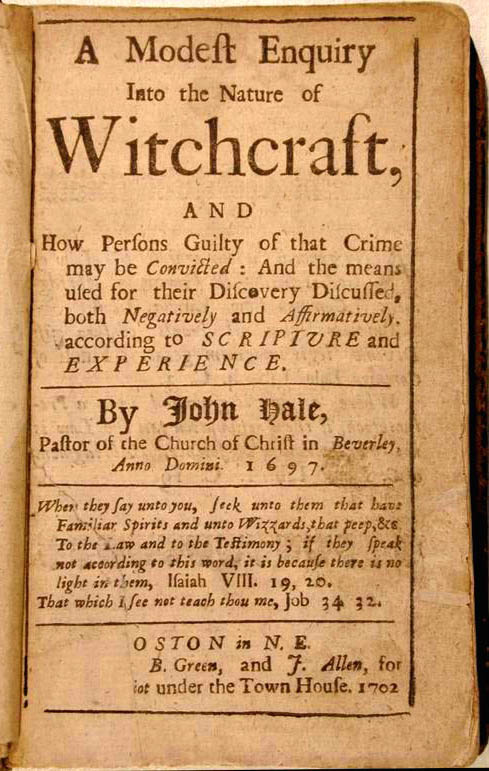
A Modest Enquiry Into the Nature of Witchcraft by John Hale (Boston, 1697)
In the early 1600s, after contact had been made with Europeans, large numbers of the indigenous peoples in the northeast of what is now the United States were killed by virgin soil epidemics such as smallpox, measles, influenza, and perhaps leptospirosis.[79][80] Between 1617 and 1619, what was possibly smallpox killed approximately 90% of the Massachusetts Bay Native Americans.[81]
The first English settlers in Massachusetts, the Pilgrims, arrived via the Mayflower[82] at Plymouth in 1620, and developed friendly relations with the native Wampanoag people.[83] This was the second successful permanent English colony in the part of North America that later became the United States, after the Jamestown Colony. The event known as the "First Thanksgiving" was celebrated by the Pilgrims after their first harvest in the New World which lasted for three days. The Pilgrims were soon followed by other Puritans, who established the Massachusetts Bay Colony at present-day Boston in 1630.[84]
The Puritans, who believed the Church of England needed to be purified and experienced harassment from English authority because of their beliefs,[85] came to Massachusetts with the goal of establishing an ideal religious society.[86] Unlike the Plymouth colony, the bay colony was founded under a royal charter in 1629.[87] Both religious dissent and expansionism resulted in several new colonies being founded shortly after Plymouth and Massachusetts Bay elsewhere in New England. The Massachusetts Bay banished dissenters such as Anne Hutchinson and Roger Williams due to religious and political disagreements. In 1636, Williams founded the colony of Rhode Island and Hutchinson joined him there several years later. Religious intolerance continued. Among those who objected to this later in the century were the English Quaker preachers Alice and Thomas Curwen, who were publicly flogged and imprisoned in Boston in 1676.[88][89]
In 1641, Massachusetts expanded inland significantly, acquiring the Connecticut River Valley settlement of Springfield, which had recently disputed with, and defected from its original administrators, the Connecticut Colony.[90] This established Massachusetts's southern border in the west,[91] though surveying problems resulted in disputed territory until 1803–04.[92]
In 1691, the colonies of Massachusetts Bay and Plymouth were united (along with present-day Maine, which had previously been divided between Massachusetts and New York) into the Province of Massachusetts Bay.[93] Shortly after the arrival of the new province's first governor, William Phips, the Salem witch trials took place, where a number of men and women were hanged for alleged witchcraft.[94]
The most destructive earthquake yet known in New England occurred in 1755, causing considerable damage across Massachusetts.[95][96]
The Revolutionary War

"Percey's Rescue at Lexington," an illustration of the Battles of Lexington and Concord
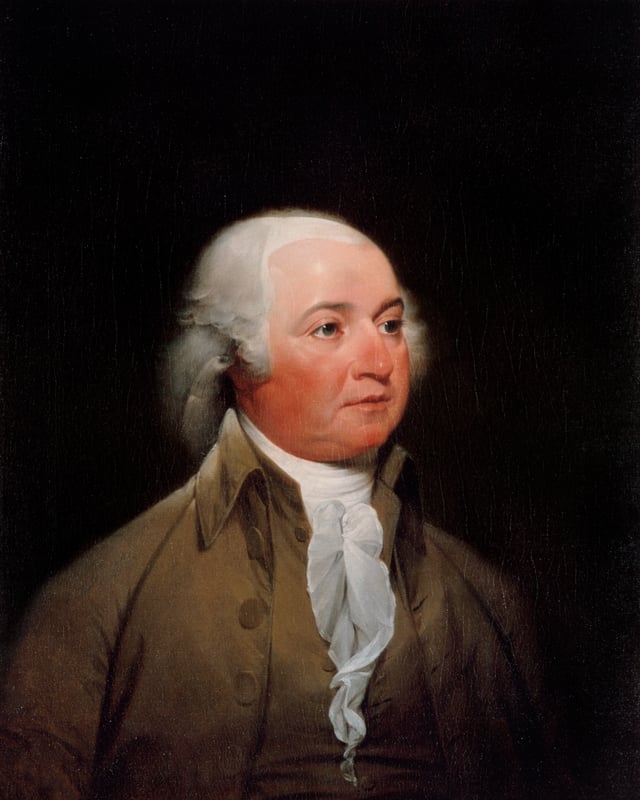
John Adams, 2nd President of the United States (1797–1801) and one of the Founding Fathers

Paul Revere's "Midnight Ride"
Massachusetts was a center of the movement for independence from Great Britain; colonists in Massachusetts had long uneasy relations with the British monarchy, including open rebellion under the Dominion of New England in the 1680s.[93] Protests against British attempts to tax the colonies after the French and Indian War ended in 1763 led to the Boston Massacre in 1770, and the 1773 Boston Tea Party escalated tensions.[97] In 1774, the Intolerable Acts targeted Massachusetts with punishments for the Boston Tea Party and further decreased local autonomy, increasing local dissent.[98] Anti-Parliamentary activity by men such as Samuel Adams and John Hancock, followed by reprisals by the British government, were a primary reason for the unity of the Thirteen Colonies and the outbreak of the American Revolution in 1775.[99]
The Battles of Lexington and Concord initiated the American Revolutionary War and were fought in the eponymous Massachusetts towns.[100] Future President George Washington took over what would become the Continental Army after the battle. His first victory was the Siege of Boston in the winter of 1775–76, after which the British were forced to evacuate the city.[101] The event is still celebrated in Suffolk County as Evacuation Day.[102] On the coast, Salem became a center for privateering. Although the documentation is incomplete, about 1,700 letters of marque, issued on a per-voyage basis, were granted during the American Revolution. Nearly 800 vessels were commissioned as privateers and are credited with capturing or destroying about 600 British ships.[103]
Federal period
Bostonian John Adams, known as the "Atlas of Independence",[104] was an important figure in both the struggle for independence as well as the formation of the new United States. Adams was highly involved in the push for separation from Britain and the writing of the Constitution of Massachusetts in 1780 which, in the Elizabeth Freeman and Quock Walker cases, effectively made Massachusetts the first state to have a constitution that declared universal rights and, as interpreted by Supreme Judicial Court Chief Justice William Cushing, abolished slavery. David McCullough points out that an equally important feature was its placing for the first time the courts as a co-equal branch separate from the executive.[105] (The Constitution of Vermont, adopted in 1777, represented the first partial ban on slavery. Vermont became a state in 1791 but did not fully ban slavery until 1858 with the Vermont Personal Liberty Law. The Pennsylvania Gradual Abolition Act of 1780[106] made Pennsylvania the first state to abolish slavery by statute.) Later, Adams was active in early American foreign affairs and succeeded Washington as the second United States President. His son John Quincy Adams, also from Massachusetts,[107] would go on to become the sixth United States President.
From 1786 to 1787, an armed uprising, known as Shays' Rebellion led by Revolutionary War veteran Daniel Shays wrought havoc throughout Massachusetts and ultimately attempted to seize the Federal armory.[49] The rebellion was one of the major factors in the decision to draft a stronger national constitution to replace the Articles of Confederation.[49] On February 6, 1788, Massachusetts became the sixth state to ratify the United States Constitution.[108]
19th century
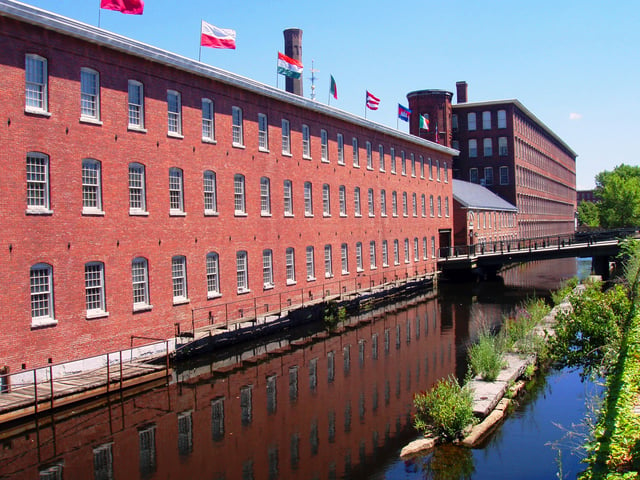
Textile mills such as the Boott Mills in Lowell made Massachusetts a leader in the Industrial Revolution in the United States.
During the 19th century, Massachusetts became a national leader in the American Industrial Revolution, with factories around cities such as Lowell and Boston producing textiles and shoes, and factories around Springfield producing tools, paper, and textiles.[110][111] The economy transformed from one based primarily on agriculture to an industrial one, initially making use of water-power and later the steam engine to power factories. Canals and railroads were used for transporting raw materials and finished goods.[112] At first, the new industries drew labor from Yankees on nearby subsistence farms, and later relied upon immigrant labor from Europe and Canada.[113][114]
Although Massachusetts was the first slave-holding colony dating back to the early 1600s, in the years leading up to the American Civil War, Massachusetts was a center of progressivist and abolitionist activity. Horace Mann made the state's school system a national model.[115] Henry David Thoreau and Ralph Waldo Emerson made major contributions to American philosophy.[116] Members of the transcendentalist movement emphasized the importance of the natural world and emotion to humanity.[116]
Although significant opposition to abolitionism existed early on in Massachusetts, resulting in anti-abolitionist riots between 1835 and 1837,[117] opposition to slavery gradually increased throughout the next few decades.[118][119] Abolitionists John Brown and Sojourner Truth lived in Springfield and Northampton, respectively, while Frederick Douglass lived in Boston and Susan B. Anthony in Adams, Massachusetts. The works of such abolitionists contributed to Massachusetts's actions during the Civil War. Massachusetts was the first state to recruit, train, and arm a Black regiment with White officers, the 54th Massachusetts Infantry Regiment.[120] In 1852, Massachusetts became the first state to pass compulsory education laws.[121]
20th century

Part of the "Big Dig" construction project; this portion is over the Charles River in Boston
With the exodus of several manufacturing companies, the area's industrial economy began to decline during the early 20th century. By the 1920s, competition from the South and Midwest, followed by the Great Depression, led to the collapse of the three main industries in Massachusetts: textiles, shoemaking, and precision mechanics.[122] This decline would continue into the later half of the century; between 1950 and 1979, the number of Massachusetts residents involved in textile manufacturing declined from 264,000 to 63,000.[123] The 1969 closure of the Springfield Armory, in particular, spurred an exodus of high-paying jobs from Western Massachusetts, which suffered greatly as it de-industrialized during the last 40 years of the 20th century.[124]
Massachusetts manufactured 3.4 percent of total United States military armaments produced during World War II, ranking tenth among the 48 states.[125] In Eastern Massachusetts, following World War II, the economy was transformed from one based on heavy industry into a service-based economy.[126] Government contracts, private investment, and research facilities led to a new and improved industrial climate, with reduced unemployment and increased per capita income. Suburbanization flourished, and by the 1970s, the Route 128 corridor was dotted with high-technology companies who recruited graduates of the area's many elite institutions of higher education.[127]
In 1987, the state received federal funding for the Central Artery/Tunnel Project. Commonly known as "the Big Dig", it was, at the time, the biggest federal highway project ever approved.[128] The project included making the Central Artery a tunnel under downtown Boston, in addition to the re-routing of several other major highways.[129] Often controversial, with numerous claims of graft and mismanagement, and with its initial price tag of $2.5 billion increasing to a final tally of over $15 billion, the Big Dig has nonetheless changed the face of Downtown Boston.[128] It has connected areas that were once divided by elevated highway (much of the raised old Central Artery was replaced with the Rose Fitzgerald Kennedy Greenway), and improved traffic conditions along a number of routes.[128][129] Additionally, Massachusetts has had a diplomatic relationship with the Japanese prefecture of Hokkaido since 1988.[130]
Notable 20th century politicians
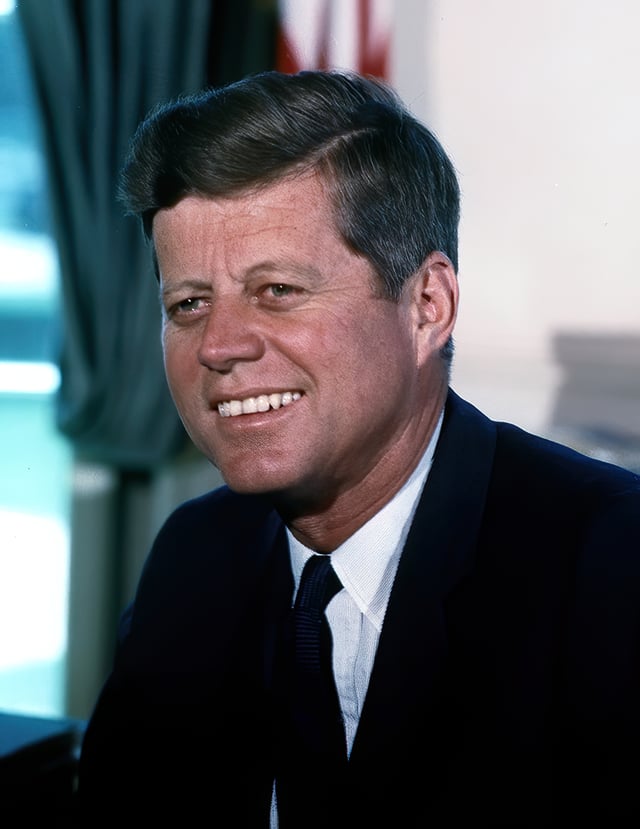
John F. Kennedy, Massachusetts native and 35th President of the United States (1961–1963)
The Kennedy family was prominent in Massachusetts politics in the 20th century. Children of businessman and ambassador Joseph P. Kennedy Sr. included John F. Kennedy, who was a senator and U.S. president before his assassination in 1963, Robert F. Kennedy, who was a senator, U.S. attorney general, and presidential candidate before his assassination in 1968, Ted Kennedy, a senator from 1962 until his death in 2009,[131] and Eunice Kennedy Shriver, a co-founder of the Special Olympics.[132] In 1966, Massachusetts became the first state to directly elect an African American to the U.S. senate with Edward Brooke.[133] George H. W. Bush, 41st President of the United States (1989–1993) was born in Milton in 1924.[134]
21st century

Boston Marathon bombing
On May 17, 2004, Massachusetts became the first state in the U.S. to legalize same-sex marriage after a Massachusetts Supreme Judicial Court ruling in November 2003 determined that the exclusion of same-sex couples from the right to a civil marriage was unconstitutional.[57] This decision was eventually superseded by the U.S. Supreme Court's affirmation of same-sex marriage in the United States in 2015.
In 2004, Massachusetts senator John Kerry who won the Democratic nomination for President of the United States narrowly lost to incumbent George W. Bush. Eight years later, former Massachusetts governor Mitt Romney (Republican nominee) lost to Barack Obama in 2012.
Two pressure cooker bombs exploded near the finish line of the Boston Marathon on April 15, 2013, at around 2:49 pm EDT. The explosions killed three civilians and injured an estimated 264 others. The Federal Bureau of Investigation (FBI) later identified the suspects as brothers Dzhokhar Tsarnaev and Tamerlan Tsarnaev. The ensuing manhunt ended on April 19 when thousands of law enforcement officers searched a 20-block area of nearby Watertown. Dzhokhar later said that he was motivated by extremist Islamic beliefs and learned to build explosive devices from Inspire, the online magazine of al-Qaeda in the Arabian Peninsula.
Geography

A portion of the north-central Pioneer Valley in Sunderland. The campus of the University of Massachusetts Amherst is visible in the background.
Massachusetts is the 7th-smallest state in the United States. It is located in the New England region of the northeastern United States and has an area of 10,555 square miles (27,340 km2), 25.7% of which is water. Several large bays distinctly shape its coast. Boston is the largest city, at the inmost point of Massachusetts Bay, and the mouth of the Charles River.
Despite its small size, Massachusetts features numerous topographically distinctive regions. The large coastal plain of the Atlantic Ocean in the eastern section of the state contains Greater Boston, along with most of the state's population,[41] as well as the distinctive Cape Cod peninsula. To the west lies the hilly, rural region of Central Massachusetts, and beyond that, the Connecticut River Valley. Along the western border of Western Massachusetts lies the highest elevated part of the state, the Berkshires.
The U.S. National Park Service administers a number of natural and historical sites in Massachusetts.[137] Along with twelve national historic sites, areas, and corridors, the National Park Service also manages the Cape Cod National Seashore and the Boston Harbor Islands National Recreation Area.[137] In addition, the Department of Conservation and Recreation maintains a number of parks, trails, and beaches throughout Massachusetts.[138]
Ecology
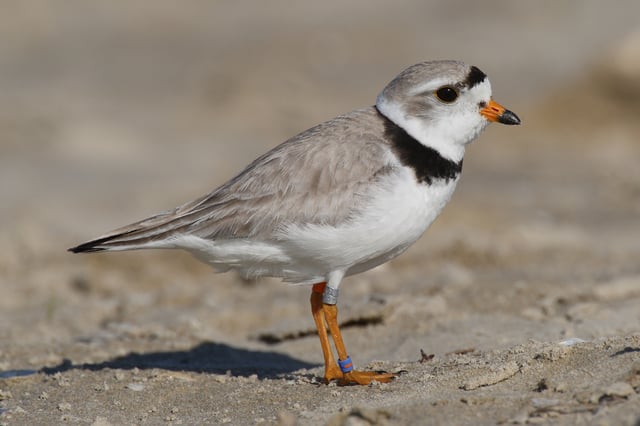
Many coastal areas in Massachusetts provide breeding areas for species such as the piping plover.
The primary biome of inland Massachusetts is temperate deciduous forest.[139] Although much of Massachusetts had been cleared for agriculture, leaving only traces of old-growth forest in isolated pockets, secondary growth has regenerated in many rural areas as farms have been abandoned.[140] Currently, forests cover around 62% of Massachusetts.[141] The areas most affected by human development include the Greater Boston area in the east and the Springfield metropolitan area in the west, although the latter includes agricultural areas throughout the Connecticut River Valley.[142] There are currently 219 endangered species in Massachusetts.[143]
A number of species are doing well in the increasingly urbanized Massachusetts. Peregrine falcons utilize office towers in larger cities as nesting areas,[144] and the population of coyotes, whose diet may include garbage and roadkill, has been increasing in recent decades.[145] White-tailed deer, raccoons, wild turkeys, and eastern gray squirrels are also found throughout Massachusetts. In more rural areas in the western part of Massachusetts, larger mammals such as moose and black bears have returned, largely due to reforestation following the regional decline in agriculture.[146]
Massachusetts is located along the Atlantic Flyway, a major route for migratory waterfowl along the eastern coast.[147] Lakes in central Massachusetts provide habitat for many species of fish and waterfowl, but some species such as the common loon are becoming rare.[148] A significant population of long-tailed ducks winter off Nantucket. Small offshore islands and beaches are home to roseate terns and are important breeding areas for the locally threatened piping plover.[149] Protected areas such as the Monomoy National Wildlife Refuge provide critical breeding habitat for shorebirds and a variety of marine wildlife including a large population of grey seals.
Freshwater fish species in Massachusetts include bass, carp, catfish, and trout, while saltwater species such as Atlantic cod, haddock, and American lobster populate offshore waters.[150] Other marine species include Harbor seals, the endangered North Atlantic right whales, as well as humpback whales, fin whales, minke whales, and Atlantic white-sided dolphins.
The European corn borer, a significant agricultural pest, was first found in North America near Boston, Massachusetts in 1917.[151]
Climate

Köppen climate types in Massachusetts
Most of Massachusetts has a humid continental, with cold winters and warm summers. Far southeast coastal areas are the broad transition zone to Humid Subtropical climates. The warm to hot summers render the oceanic climate rare in this transition, only applying to exposed coastal areas such as on the peninsula of Barnstable County. The climate of Boston is quite representative for the commonwealth, characterized by summer highs of around 81 °F (27 °C) and winter highs of 35 °F (2 °C), and is quite wet. Frosts are frequent all winter, even in coastal areas due to prevailing inland winds. Due to its location near the Atlantic, Massachusetts is vulnerable to nor'easters, hurricanes and tropical storms.
| Location | July (°F) | July (°C) | January (°F) | January (°C) |
|---|---|---|---|---|
| Boston | 81/65 | 27/18 | 36/22 | 2/–5 |
| Worcester | 79/61 | 26/16 | 31/17 | 0/–8 |
| Springfield | 84/62 | 27/17 | 34/17 | 1/–8 |
| New Bedford | 80/65 | 26/18 | 37/23 | 3/–4 |
| Quincy | 80/61 | 26/16 | 33/18 | 1/–7 |
| Plymouth | 80/61 | 27/16 | 38/20 | 3/–6 |
Demographics
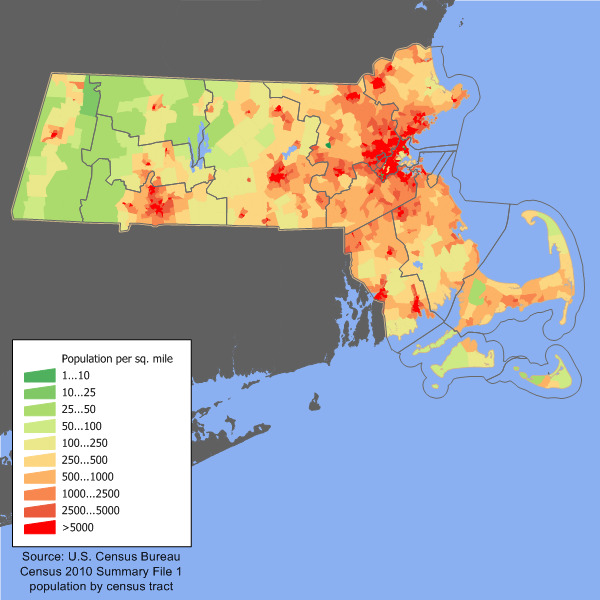
Massachusetts population density map. The centers of high-density settlement, from east to west, are Boston, Worcester, Springfield, and Pittsfield, respectively.
| Historical population | |||
|---|---|---|---|
| Census | Pop. | %± | |
| 1790 | 378,787 | — | |
| 1800 | 422,845 | 11.6% | |
| 1810 | 472,040 | 11.6% | |
| 1820 | 523,287 | 10.9% | |
| 1830 | 610,408 | 16.6% | |
| 1840 | 737,699 | 20.9% | |
| 1850 | 994,514 | 34.8% | |
| 1860 | 1,231,066 | 23.8% | |
| 1870 | 1,457,351 | 18.4% | |
| 1880 | 1,783,085 | 22.4% | |
| 1890 | 2,238,947 | 25.6% | |
| 1900 | 2,805,346 | 25.3% | |
| 1910 | 3,366,416 | 20.0% | |
| 1920 | 3,852,356 | 14.4% | |
| 1930 | 4,249,614 | 10.3% | |
| 1940 | 4,316,721 | 1.6% | |
| 1950 | 4,690,514 | 8.7% | |
| 1960 | 5,148,578 | 9.8% | |
| 1970 | 5,689,170 | 10.5% | |
| 1980 | 5,737,037 | 0.8% | |
| 1990 | 6,016,425 | 4.9% | |
| 2000 | 6,349,097 | 5.5% | |
| 2010 | 6,547,629 | 3.1% | |
| Est. 2018 | 6,902,149 | 5.4% | |
| [153][154][155] | |||
The United States Census Bureau estimated that the population of Massachusetts was 6,902,149 on July 1, 2018, a 5.41% increase since the 2010 United States Census.[155]
As of 2014, Massachusetts was estimated to be the third-most densely populated U.S. state, with 839.4 people per square mile,[156] behind New Jersey and Rhode Island. In 2014, Massachusetts had 1,011,811 foreign-born residents or 15% of the population.[156]
Most Bay State residents live within the Boston Metropolitan Area, also known as Greater Boston, which includes Boston and its proximate surroundings but also extending to Greater Lowell and to Worcester. The Springfield metropolitan area, also known as Greater Springfield, is also a major center of population. Demographically, the center of population of Massachusetts is located in the town of Natick.[157][158]
Like the rest of the Northeastern United States, the population of Massachusetts has continued to grow in the late 20th and early 21st centuries. Massachusetts is the fastest growing state in New England and the 25th fastest growing state in the United States.[159] Population growth was largely due to a relatively high quality of life and a large higher education system in the state.[159]
Foreign immigration is also a factor in the state's population growth, causing the state's population to continue to grow as of the 2010 Census (particularly in Massachusetts gateway cities where costs of living are lower).[160][161] 40% of foreign immigrants were from Central or South America, according to a 2005 Census Bureau study, with many of the remainder from Asia. Many residents who have settled in Greater Springfield claim Puerto Rican descent.[160] Many areas of Massachusetts showed relatively stable population trends between 2000 and 2010.[161] Exurban Boston and coastal areas grew the most rapidly, while Berkshire County in far Western Massachusetts and Barnstable County on Cape Cod were the only counties to lose population as of the 2010 Census.[161]
By sex, 48.4% were male and 51.6% were female in 2014. In terms of age, 79.2% were over 18 years old and 14.8% were over 65 years old.[156]
Race and ancestry

Saint Patrick's Day parade in Scituate, the municipality with the highest percentage identifying Irish ancestry in the United States, at 47.5% in 2010.[162] Irish Americans constitute the largest ethnicity in Massachusetts.
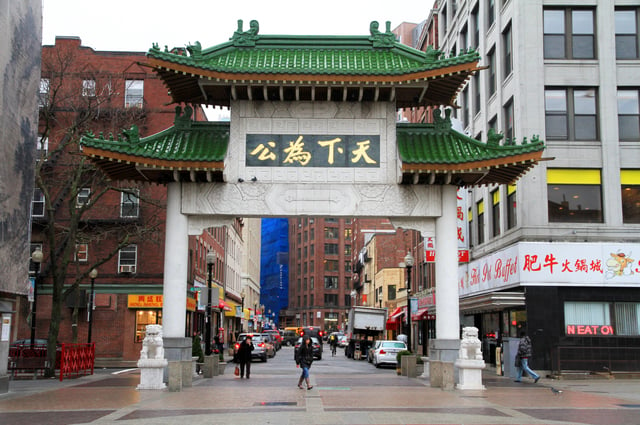
Boston's Chinatown, with its paifang gate, is home to many Chinese and also Vietnamese restaurants.
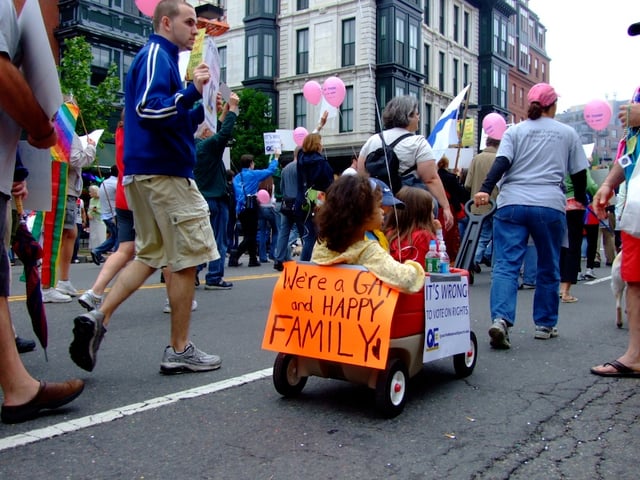
Boston gay pride march, held annually in June. Massachusetts became the first U.S. state to legalize same-sex marriage in 2004.
As of 2014, in terms of race and ethnicity, Massachusetts was 83.2% White (73.7% Non-Hispanic White), 8.8% Black or African American, 0.5% Native American and Alaska Native, 6.3% Asian American, <0.1% Native Hawaiian and Other Pacific Islander, 2.1% from some other race, and 3.1% from two or more races. Hispanics and Latinos of any race made up 11.2% of the population.[156]
The state's most populous ethnic group, non-Hispanic white, has declined from 95.4% in 1970 to 73.7% in 2014.[156][163] As of 2011, non-Hispanic whites were involved in 63.6% of all the births,[164] while 36.4% of the population of Massachusetts younger than age 1 was minorities (meaning that they had at least one parent who was not non-Hispanic white).[165]
As late as 1795, the population of Massachusetts was nearly 95% of English ancestry.[166] During the early and mid-19th century, immigrant groups began arriving in Massachusetts in large numbers; first from Ireland in the 1840s;[167] today the Irish and part-Irish are the largest ancestry group in the state at nearly 25% of the total population. Others arrived later from Quebec as well as places in Europe such as Italy, Portugal, and Poland.[168] In the early 20th century, a number of African Americans migrated to Massachusetts, although in somewhat fewer numbers than many other Northern states.[169] Later in the 20th century, immigration from Latin America increased considerably. Over 156,000 Chinese Americans made their home in Massachusetts in 2014,[170] and Boston hosts a growing Chinatown accommodating heavily traveled Chinese-owned bus lines to and from Chinatown, Manhattan in New York City. Massachusetts also has large Puerto Rican, Dominican, Haitian, Cape Verdean and Brazilian populations. Boston's South End and Jamaica Plain are both gay villages, as is nearby Provincetown, Massachusetts on Cape Cod.
The largest ancestry group in Massachusetts are the Irish (22.5% of the population), who live in significant numbers throughout the state but form more than 40% of the population along the South Shore in Norfolk and Plymouth counties (in both counties overall, Irish-Americans comprise more than 30% of the population). Italians form the second-largest ethnic group in the state (13.5%), but only form a plurality in some suburbs north of Boston and a few towns in the Berkshires. English is the third-largest ancestry in Massachusetts (11.4%), and have lived in the region the longest but only form a plurality in some towns in western Massachusetts. French and French Canadian people also form a significant part of the state's population (10.7%),[171] with sizable populations in Bristol, Hampden, Worcester Counties.[172][173] Lowell is home to the second-largest Cambodian community of the nation.[174] Massachusetts is home to a small community of Greek Americans as well, which according to the American Community Survey there are 83,701 of them scattered along the state (1.2% of the total state population).[175] There are also several populations of Native Americans in Massachusetts. The Wampanoag tribe maintains reservations at Aquinnah on Martha's Vineyard and at Mashpee on Cape Cod—with an ongoing native language revival project underway since 1993, while the Nipmuc maintain two state-recognized reservations in the central part of the state, including one at Grafton.[176]
Massachusetts has avoided many forms of racial strife seen elsewhere in the US, but examples such as the successful electoral showings of the nativist (mainly anti-Catholic) Know Nothings in the 1850s,[177] the controversial Sacco and Vanzetti executions in the 1920s,[178] and Boston's opposition to desegregation busing in the 1970s[179] show that the ethnic history of Massachusetts was not completely harmonious.
Languages
The most common varieties of American English spoken in Massachusetts, other than General American, are the cot-caught distinct, rhotic, western Massachusetts dialect and the cot-caught merged, non-rhotic, eastern Massachusetts dialect (popularly known as a "Boston accent").[180]
| Language | Percentage of population (as of 2010)[181] |
|---|---|
| Spanish | 7.50% |
| Portuguese | 2.97% |
| Chinese (including Cantonese and Mandarin) | 1.59% |
| French (including New England French) | 1.11% |
| French Creole | 0.89% |
| Italian | 0.72% |
| Russian | 0.62% |
| Vietnamese | 0.58% |
| Greek | 0.41% |
| Arabic and Khmer (Cambodian) (including all Austroasiatic languages) (tied) | 0.37% |
As of 2010, 78.93% (4,823,127) of Massachusetts residents age 5 and older spoke English at home as a first language, while 7.50% (458,256) spoke Spanish, 2.97% (181,437) Portuguese, 1.59% (96,690) Chinese (which includes Cantonese and Mandarin), 1.11% (67,788) French, 0.89% (54,456) French Creole, 0.72% (43,798) Italian, 0.62% (37,865) Russian, and Vietnamese was spoken as a primary language by 0.58% (35,283) of the population over the age of five. In total, 21.07% (1,287,419) of Massachusetts's population aged 5 and older spoke a first language other than English.[156][181]
Religion
Massachusetts was founded and settled by Brownist Puritans in 1620[85] and soon after by other groups of Separatists/Dissenters, Nonconformists and Independents from 17th century England.[83] A majority of people in Massachusetts today remain Christians.[156] The descendants of the Puritans belong to many different churches; in the direct line of inheritance are the various Congregational churches, the United Church of Christ and congregations of the Unitarian Universalist Association. The headquarters of the Unitarian Universalist Association, long located on Beacon Hill, is now located in South Boston.[184][185] Many Puritan descendants also dispersed to other Protestant denominations. Some disaffiliated along with Roman Catholics and other Christian groups in the wake of modern secularization.
Today, Christians make up 57% of the state's population, with Protestants making up 21% of them. Roman Catholics make up 34% and now predominate because of massive immigration from primarily Catholic countries and regions – chiefly Ireland, Italy, Poland, Portugal, Quebec, and Latin America. Both Protestant and Roman Catholic communities have been in decline since the late 20th century, due to the rise of irreligion in New England. It is the most irreligious region of the country, along with the Western United States. A significant Jewish population immigrated to the Boston and Springfield areas between 1880 and 1920. Jews currently make up 3% of the population. Mary Baker Eddy made the Boston Mother Church of Christian Science serve as the world headquarters of this new religious movement. Buddhists, Pagans, Hindus, Seventh-day Adventists, Muslims, and Mormons may also be found. Kripalu Center in Stockbridge, the Shaolin Meditation Temple in Springfield, and the Insight Meditation Center in Barre are examples of non-Abrahamic religious centers in Massachusetts. According to 2010 data from The Association of Religion Data Archives, (ARDA) the largest single denominations are the Catholic Church with 2,940,199 adherents; the United Church of Christ with 86,639 adherents; and the Episcopal Church with 81,999 adherents.[186] 32% of the population identifies as having no religion.[187]
Education

Towns in Massachusetts by combined mean SAT of their public high school district for the 2015–2016 academic year[188]
In 2018, Massachusetts's overall educational system was ranked the top among all fifty U.S. states by U.S. News & World Report.[189] Massachusetts was the first state in North America to require municipalities to appoint a teacher or establish a grammar school with the passage of the Massachusetts Education Law of 1647,[190] and 19th century reforms pushed by Horace Mann laid much of the groundwork for contemporary universal public education[191][192] which was established in 1852.[121] Massachusetts is home to the oldest school in continuous existence in North America (The Roxbury Latin School, founded in 1645), as well as the country's oldest public elementary school (The Mather School, founded in 1639),[193] its oldest high school (Boston Latin School, founded in 1635),[194] its oldest continuously operating boarding school (The Governor's Academy, founded in 1763),[195] its oldest college (Harvard University, founded in 1636),[196] and its oldest women's college (Mount Holyoke College, founded in 1837).[197]
Massachusetts is home to 121 institutions of higher education.[200] Harvard University and the Massachusetts Institute of Technology, both located in Cambridge, consistently rank among the world's best private universities and universities in general.[201] In addition to Harvard and MIT, several other Massachusetts universities currently rank in the top 50 at the undergraduate level nationally in the widely cited rankings of U.S. News and World Report: Tufts University (#27), Boston College (#32), Brandeis University (#34), Boston University (#37) and Northeastern University (#40). Massachusetts is also home to three of the top five U.S. News and World Report's best Liberal Arts Colleges: Williams College (#1), Amherst College (#2), and Wellesley College (#4).[202] The public University of Massachusetts (nicknamed UMass) features five campuses in the state, with its flagship campus in Amherst that enrolls over 25,000 students.[203][204]
Economy

Cape Cod Bay, a leading tourist destination in Massachusetts. Tourism is important to the state's economy.
The United States Bureau of Economic Analysis estimates that the Massachusetts gross state product in 2017 was US$527 billion.[205] The per capita personal income in 2012 was $53,221, making it the third-highest state in the nation.[206] As of January 2019, Massachusetts general minimum wage in the state is $12 per hour while the minimum wage for tipped workers is $4.35 an hour.[207]
In 2015, twelve Fortune 500 companies were located in Massachusetts: Liberty Mutual, Massachusetts Mutual Life Insurance Company, TJX Companies, General Electric, Raytheon, American Tower, Global Partners, Thermo Fisher Scientific, State Street Corporation, Biogen, Eversource Energy, and Boston Scientific.[208] CNBC's list of "Top States for Business for 2014" has recognized Massachusetts as the 25th-best state in the nation for business,[209] and for the second year in a row the state was ranked by Bloomberg as the most innovative state in America.[210] According to a 2013 study by Phoenix Marketing International, Massachusetts had the sixth-largest number of millionaires per capita in the United States, with a ratio of 6.73 percent.[211] Billionaires living in the state include past and present leaders (and related family) of local companies such as Fidelity Investments, New Balance, Kraft Group, Boston Scientific, and the former Continental Cablevision.[212]
Massachusetts has three foreign-trade zones, the Massachusetts Port Authority of Boston, the Port of New Bedford, and the City of Holyoke.[213] Boston-Logan International Airport is the busiest airport in New England, serving 33.4 million total passengers in 2015, and witnessing rapid growth in international air traffic since 2010.[214]
Sectors vital to the Massachusetts economy include higher education, biotechnology, information technology, finance, health care, tourism, manufacturing, and defense. The Route 128 corridor and Greater Boston continue to be a major center for venture capital investment,[215] and high technology remains an important sector. In recent years tourism has played an ever-important role in the state's economy, with Boston and Cape Cod being the leading destinations.[216] Other popular tourist destinations include Salem, Plymouth, and the Berkshires. Massachusetts is the sixth-most popular tourist destination for foreign travelers.[217] In 2010, the Great Places in Massachusetts Commission published '1,000 Great Places in Massachusetts' that identified 1,000 sites across the commonwealth to highlight the diverse historic, cultural, and natural attractions.[218]
While manufacturing comprised less than 10% of Massachusetts's gross state product in 2016, the Commonwealth ranked 16th in the nation in total manufacturing output in the United States.[219] This includes a diverse array of manufactured goods such as medical devices, paper goods, specialty chemicals and plastics, telecommunications and electronics equipment, and machined components.[220][221]
As of 2012, there were 7,755 farms in Massachusetts encompassing a total of 523,517 acres (2,120 km2), averaging 67.5 acres (0.273 km2) apiece.[222] Particular agricultural products of note include green house products making up more than one third of the state's agricultural output, cranberries, sweet corn and apples are also large sectors of production.[223] Massachusetts is the second-largest cranberry-producing state in the union after Wisconsin.[224]
The more than 33,000 nonprofits in Massachusetts employ one-sixth of the state's workforce.[225] In 2007, Governor Deval Patrick signed into law a state holiday, Nonprofit Awareness Day.
In February 2017, U.S. News & World Report ranked Massachusetts the best state in the United States based upon 60 metrics including healthcare, education, crime, infrastructure, opportunity, economy, and government. The Bay State ranked number one in education, number two in healthcare, and number five in the handling of the economy.[65]
Taxation
Depending on how it is calculated, state and local tax burden in Massachusetts has been estimated among U.S. states and Washington D.C. as 21st-highest (11.44% or $6,163 per year for a household with nationwide median income)[226] or 25th-highest overall with below-average corporate taxes (39th-highest), above-average personal income taxes, (13th-highest), above-average sales tax (18th-highest), and below-average property taxes (46th-highest).[227] In the 1970s, the Commonwealth ranked as a relatively high-tax state, gaining the pejorative nickname "Taxachusetts". This was followed by a round of tax limitations during the 1980s—a conservative period in American politics—including Proposition 2½.[228]
As of January 1, 2016, Massachusetts has a flat-rate personal income tax of 5.1%,[229] after a 2002 voter referendum to eventually lower the rate to 5.0%[230] as amended by the legislature.[231] There is a tax exemption for income below a threshold that varies from year to year. The corporate income tax rate is 8.8%,[232] and the short-term capital gains tax rate is 12%.[233] An unusual provision allows filers to voluntarily pay at the pre-referendum 5.85% income tax rate, which is done by between one and two thousand taxpayers per year.[234]
The state imposes a 6.25% sales tax[232] on retail sales of tangible personal property—except for groceries, clothing (up to $175.00), and periodicals.[235] The sales tax is charged on clothing that costs more than $175.00, for the amount exceeding $175.00.[235] Massachusetts also charges a use tax when goods are bought from other states and the vendor does not remit Massachusetts sales tax; taxpayers report and pay this on their income tax forms or dedicated forms, though there are "safe harbor" amounts that can be paid without tallying up actual purchases (except for purchases over $1,000).[235] There is no inheritance tax and limited Massachusetts estate tax related to federal estate tax collection.[233]
Energy
Massachusetts's electricity generation market was made competitive in 1998, enabling retail customers to change suppliers without changing utility companies.[236] In 2016, Massachusetts consumed 1,423 trillion BTU,[237] making it the eighth-lowest state in terms of consumption of energy per capita, and 32.5 percent of that energy came from natural gas.[237] In 2014 and 2015, Massachusetts was ranked as the most energy efficient state the United States[238][239] while Boston is the most efficient city,[240] but it had the fourth-highest retail electricity prices of any state.[237] In 2016, renewable energy was about 6.2 percent of total energy consumed in the state, ranking 36th.[237]
Transportation

The Massachusetts Bay Transportation Authority, serving Greater Boston
Massachusetts has 10 regional metropolitan planning organizations and three non-metropolitan planning organizations covering the remainder of the state;[241] statewide planning is handled by the Massachusetts Department of Transportation. Transportation is the single largest source of greenhouse emissions in Massachusetts.[242]
Regional public transportation
Long-distance rail and bus
Amtrak operates inter-city rail, including the high-speed Acela service to cities such as Providence, New Haven, New York City, and Washington, DC from South Station. From North Station the Amtrak Downeaster serves Portland, Maine and Brunswick, Maine.[250] Amtrak also runs east-west from Boston South Station to Worcester, Springfield, and eventually Chicago, Illinois; and north-south from the Pioneer Valley to New Haven, Connecticut via Hartford. Amtrak carries more passengers between Boston and New York than all airlines combined (about 54% of market share in 2012).[251] but has infrequent trips to other cities. There, more frequent intercity service is provided by private bus carriers, including Peter Pan Bus Lines (headquartered in Springfield), Greyhound Lines, OurBus and BoltBus. Various Chinatown bus lines depart for New York from South Station in Boston.
MBTA Commuter Rail services run throughout the larger Greater Boston area, including service to Worcester, Fitchburg, Haverhill, Newburyport, Lowell, and Plymouth.[252] This overlaps with the service areas of neighboring regional transportation authorities. As of the summer of 2013 the Cape Cod Regional Transit Authority in collaboration with the MBTA and the Massachusetts Department of Transportation (MassDOT) is operating the CapeFLYER providing passenger rail service between Boston and Cape Cod.[253][254]
Hartford-Springfield Commuter Rail began operation in 2018.
Ferry
The Woods Hole, Martha's Vineyard and Nantucket Steamship Authority regulates freight and passenger ferry service to the islands of Massachusetts including Martha's Vineyard and Nantucket.[255]
Rail freight
Air service

Worcester, second-largest city in the state, with Worcester Regional Airport tower in the background
The major airport in the state is Boston-Logan International Airport. The airport served 33.5 million passengers in 2015, up from 31.6 million in 2014,[214] and is used by around 40 airlines with a total of 103 gates.[258] Logan International Airport has service to numerous cities throughout the United States, as well as international service to Canada, Mexico, Brazil, the Caribbean, Europe, and Asia.[259] Logan, Hanscom Field in Bedford, and Worcester Regional Airport are operated by Massport, an independent state transportation agency.[259] Massachusetts has 39 public-use airfields,[260] and over 200 private landing spots.[261] Some airports receive funding from the Aeronautics Division of the Massachusetts Department of Transportation and the Federal Aviation Administration; the FAA is also the primary regulator of Massachusetts air travel.[262]
Roads
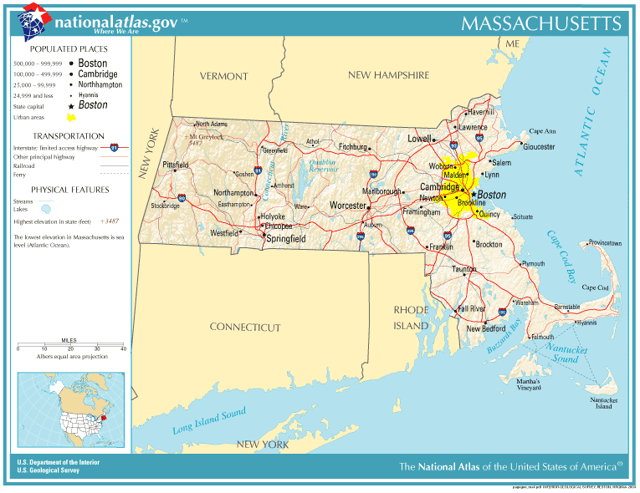
Prominent roads and cities in Massachusetts
There are a total of 31,300 miles (50,400 km) of interstates and other highways in Massachusetts.[263] Interstate 90 (I-90, also known as the Massachusetts Turnpike), is the longest interstate in Massachusetts. The route travels 136 mi (219 km) generally west to east, entering Massachusetts at the New York state line in the town of West Stockbridge, and passes just north of Springfield, just south of Worcester and through Framingham before terminating near Logan International Airport in Boston.[264] Other major interstates include I-91, which travels generally north and south along the Connecticut River; I-93, which travels north and south through central Boston, then passes through Methuen before entering New Hampshire; and I-95, which connects Providence, Rhode Island with Greater Boston, forming a partial loop concurrent with Route 128 around the more urbanized areas before continuing north along the coast into New Hampshire.
I-495 forms a wide loop around the outer edge of Greater Boston. Other major interstates in Massachusetts include I-291, I-391, I-84, I-195, I-395, I-290, and I-190. Major non-interstate highways in Massachusetts include U.S. Routes 1, 3, 6, and 20, and state routes 2, 3, 9, 24, and 128. A great majority of interstates in Massachusetts were constructed during the mid-20th century, and at times were controversial, particularly the intent to route I-95 northeastwards from Providence, Rhode Island, directly through central Boston, first proposed in 1948. Opposition to continued construction grew, and in 1970 Governor Francis W. Sargent issued a general prohibition on most further freeway construction within the I-95/Route 128 loop in the Boston area.[265] A massive undertaking to bring I-93 underground in downtown Boston, called the Big Dig, brought the city's highway system under public scrutiny for its high cost and construction quality.[128]
Government and politics
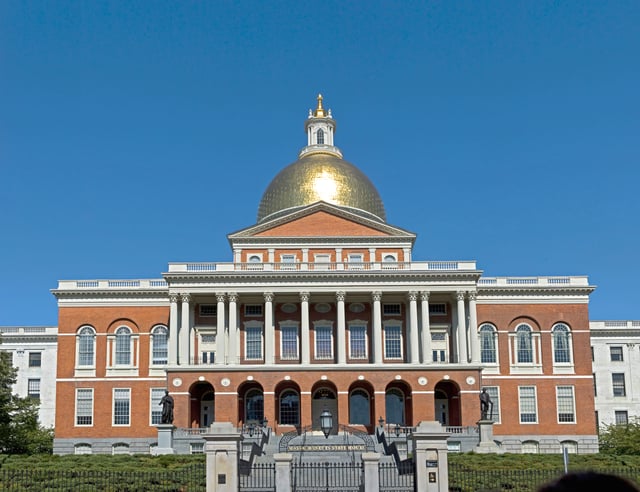
The Massachusetts State House, topped by its golden dome, faces Boston Common on Beacon Hill.
Massachusetts has a long political history; earlier political structures included the Mayflower Compact of 1620, the separate Massachusetts Bay and Plymouth colonies, and the combined colonial Province of Massachusetts. The Massachusetts Constitution was ratified in 1780 while the Revolutionary War was in progress, four years after the Articles of Confederation was drafted, and eight years before the present United States Constitution was ratified on June 21, 1788. Drafted by John Adams, the Massachusetts Constitution is currently the oldest functioning written constitution in continuous effect in the world.[266][267][268] It has been amended 120 times, most recently in 2000.
Massachusetts politics since the second half of the 20th century have generally been dominated by the Democratic Party, and the state has a reputation for being the most liberal state in the country.[269] In 1974, Elaine Noble became the first openly lesbian or gay candidate elected to a state legislature in US history.[270] The state housed the first openly gay member of the United States House of Representatives, Gerry Studds, in 1972[271] and in 2004, Massachusetts became the first state to allow same-sex marriage.[57] Massachusetts has a pro-sanctuary city law.[272]
Government

Charlie Baker (R), the 72nd and current Governor of Massachusetts
The Government of Massachusetts is divided into three branches: Executive, Legislative, and Judicial. The governor of Massachusetts heads the executive branch; duties of the governor include signing or vetoing legislation, filling judicial and agency appointments, granting pardons, preparing an annual budget, and commanding the Massachusetts National Guard.[273] Massachusetts governors, unlike those of most other states, are addressed as His/Her Excellency.[273] The current governor is Charlie Baker,[274] a Republican from Swampscott.[275] The executive branch also includes the Executive Council, which is made up of eight elected councilors and the Lieutenant Governor seat,[273] which is currently occupied by Karyn Polito (R–Shrewsbury).[274]
Abilities of the Council include confirming gubernatorial appointments and certifying elections.[273] The Massachusetts House of Representatives and Massachusetts Senate comprise the legislature of Massachusetts, known as the Massachusetts General Court.[273] The House consists of 160 members while the Senate has 40 members.[273] Leaders of the House and Senate are chosen by the members of those bodies; the leader of the House is known as the Speaker while the leader of the Senate is known as the President.[273] Each branch consists of several committees.[273] Members of both bodies are elected to two-year terms.[276]
The Judicial branch is headed by the Massachusetts Supreme Judicial Court, which serves over a number of lower courts.[273] The Supreme Judicial Court is made up of a chief justice and six associate justices.[273] Judicial appointments are made by the governor and confirmed by the executive council.[273]
The Congressional delegation from Massachusetts is entirely Democratic.[277] Currently, the Senators are Elizabeth Warren and Ed Markey while the Representatives are Richard Neal (1st), Jim McGovern (2nd), Lori Trahan (3rd), Joseph Kennedy III (4th), Katherine Clark (5th), Seth Moulton (6th), Ayanna Pressley (7th), Stephen Lynch (8th), and Bill Keating (9th).[278]
Federal court cases are heard in the United States District Court for the District of Massachusetts, and appeals are heard by the United States Court of Appeals for the First Circuit.[279] In U.S. presidential elections since 2012, Massachusetts has been allotted 11 votes in the electoral college, out of a total of 538.[280] Like most states, Massachusetts's electoral votes are granted in a winner-take-all system.[281]
Politics

Rep. Joe Kennedy III, Senator Elizabeth Warren, and former Rep. Barney Frank campaign during the Boston Pride Parade
Throughout the mid-20th century, Massachusetts gradually shifted from a Republican-leaning state to one largely dominated by Democrats; the 1952 victory of John F. Kennedy over incumbent Senator Henry Cabot Lodge, Jr. is seen as a watershed moment in this transformation. His younger brother Edward M. Kennedy held that seat until his death from a brain tumor in 2009.[282] Since the time of John Kennedy, Massachusetts has gained a reputation as being a politically liberal state and is often used as an archetype of modern liberalism, hence the usage of the phrase "Massachusetts liberal."[283]
Massachusetts routinely votes for the Democratic Party, with the core concentrations in the Boston metro area, the Cape and Islands, and Western Massachusetts outside Hampden County. Pockets of Republican strength are in the central areas along the I-495 crescent, Hampden County, and communities on the south and north shores,[284] but the state as a whole has not given its Electoral College votes to a Republican in a presidential election since Ronald Reagan carried it in 1984. Additionally, Massachusetts provided Reagan with his smallest margins of victory in both the 1980[285] and 1984 elections.[286] When averaging the presidential election results from 2000 to 2016 in Massachusetts, Democratic nominees collected 60.8% of the vote compared to 35.1% for Republican nominees.[287] In the 2004 election, the state gave Massachusetts senator and Presidential candidate John Kerry 61.9% of the vote, his best showing in any state.[288]
Democrats have an absolute grip on the Massachusetts congressional delegation; there are no Republicans elected to serve at the federal level. Both Senators and all nine Representatives are Democrats; only one Republican (former Senator Scott Brown) has been elected to either house of Congress from Massachusetts since 1994. Massachusetts is the most populous state to be represented in the United States Congress entirely by a single party.
| Massachusetts Registered Voter Enrollment: October 2018.[289] | ||||
|---|---|---|---|---|
| Party | Voters | Percentage | ||
| Democratic | 1,458,305 | 32.9% | ||
| Republican | 456,527 | 10.3% | ||
| Libertarian | 16,893 | 0.4% | ||
| Green | 3,744 | 0.1% | ||
| Other | 39,637 | 0.9% | ||
| Unaffiliated (officially Unenrolled) | 2,459,828 | 55.5% | ||
| Total | 4,434,934 | 100% | ||
As of the 2018 elections, the Democratic Party holds a super-majority over the Republican Party in both chambers of the Massachusetts General Court (state legislature). Out of the state house's 160 seats, Democrats hold 127 seats (79%) compared to the Republican Party's 32 seats (20%), an independent sits in the remaining one,[290] and 34 out of the 40 seats in the state senate (85%) belong to the Democratic Party compared to the Republican Party's six seats (15%).[291] Both houses of the legislature have had Democratic majorities since the 1950s.
Despite the state's Democratic-leaning tendency, Massachusetts is more open to electing Republicans as Governor: only one Democrat (Deval Patrick) has served as governor since 1991, and among gubernatorial election results from 2002 to 2018, Republican nominees garnered 48.4% of the vote compared to 45.7% for Democratic nominees.[287] These have been considered to be among the most moderate Republican leaders in the nation.[292][293]
A number of contemporary national political issues have been influenced by events in Massachusetts, such as the decision in 2003 by the state Supreme Judicial Court allowing same-sex marriage[294] and a 2006 bill which mandated health insurance for all Bay Staters.[295] In 2008, Massachusetts voters passed an initiative decriminalizing possession of small amounts of marijuana.[296] Voters in Massachusetts also approved a ballot measure in 2012 that legalized the medical use of marijuana.[297] Following the approval of a ballot question endorsing legalization in 2016, Massachusetts began issuing licenses for the regulated sale of recreational marijuana in June 2018. The licensed sale of recreational marijuana became legal on July 1, 2018; however, the lack of state-approved testing facilities prevented the sale of any product for several weeks.[298]
Cities, towns, and counties
There are 50 cities and 301 towns in Massachusetts, grouped into 14 counties.[299] The fourteen counties, moving roughly from west to east, are Berkshire, Franklin, Hampshire, Hampden, Worcester, Middlesex, Essex, Suffolk, Norfolk, Bristol, Plymouth, Barnstable, Dukes, and Nantucket. Eleven communities which call themselves "towns" are, by law, cities since they have traded the town meeting form of government for a mayor-council or manager-council form.[300]
Boston is the state capital and largest city in Massachusetts. The population of the city proper is 673,184,[301] and Greater Boston, with a population of 4,628,910, is the 10th largest metropolitan area in the nation.[302] Other cities with a population over 100,000 include Worcester, Springfield, Lowell, and Cambridge. Plymouth is the largest municipality in the state by land area, followed by Middleborough.[299]
Massachusetts, along with the five other New England states, features the local governmental structure known as the New England town.[303] In this structure, incorporated towns—as opposed to townships or counties—hold many of the responsibilities and powers of local government.[303] Most of the county governments were abolished by the state of Massachusetts beginning in 1997 including Middlesex County,[304] the largest county in the state by population.[305][306] The voters of these now defunct counties elect only Sheriffs and Registers of Deeds, who are part of the state government. Other counties have been reorganized, and a few still retain county councils.[307]
Arts, culture, and recreation
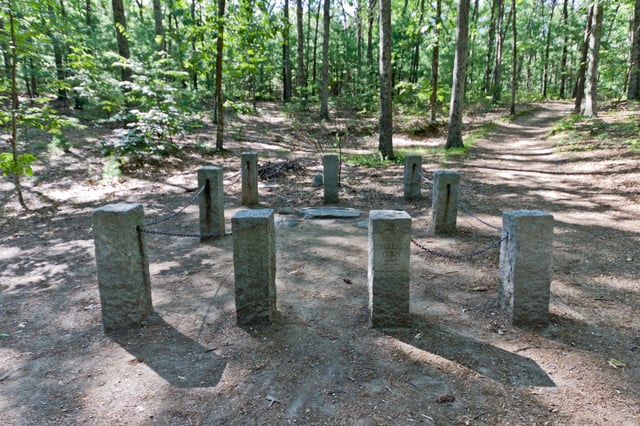
The site of Henry David Thoreau's cabin at Walden Pond in Concord
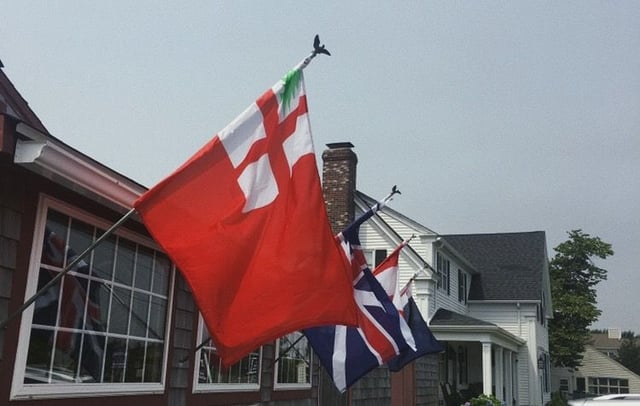
Massachusetts has the largest population of the New England states. New Englander culture and identity remains strong in Massachusetts (Flag of New England pictured above).[309]

An outdoor dance performance at Jacob's Pillow in Becket

USS Constitution fires a salute during its annual Fourth of July turnaround cruise
Massachusetts has contributed to American arts and culture. Drawing from its Native American and Yankee roots, along with later immigrant groups, Massachusetts has produced a number of writers, artists, and musicians. A number of major museums and important historical sites are also located there, and events and festivals throughout the year celebrate the state's history and heritage.[310]
Massachusetts was an early center of the Transcendentalist movement, which emphasized intuition, emotion, human individuality and a deeper connection with nature.[116] Ralph Waldo Emerson, who was born in Boston but spent much of his later life in Concord, largely created the philosophy with his 1836 work Nature, and continued to be a key figure in the movement for the remainder of his life. Emerson's friend, Henry David Thoreau, who was also involved in Transcendentalism, recorded his year spent alone in a small cabin at nearby Walden Pond in the 1854 work Walden; or, Life in the Woods.[311]
Other famous authors and poets born or strongly associated with Massachusetts include Nathaniel Hawthorne, John Updike, Emily Dickinson, Henry Wadsworth Longfellow, E.E. Cummings, Sylvia Plath, H.P. Lovecraft, Edgar Allan Poe, and Theodor Seuss Geisel, better known as "Dr. Seuss".[312][313][314] Famous painters from Massachusetts include Winslow Homer and Norman Rockwell;[314] many of the latter's works are on display at the Norman Rockwell Museum in Stockbridge.[315]
Massachusetts is also an important center for the performing arts. Both the Boston Symphony Orchestra and Boston Pops Orchestra are based in Massachusetts.[316] Other orchestras in Massachusetts include the Cape Cod Symphony Orchestra in Barnstable, the New Bedford Symphony Orchestra,[317] and the Springfield Symphony Orchestra.[318][319] Tanglewood, in western Massachusetts, is a music venue that is home to both the Tanglewood Music Festival and Tanglewood Jazz Festival, as well as the summer host for the Boston Symphony Orchestra.[320]
Other performing arts and theater organizations in Massachusetts include the Boston Ballet, the Boston Lyric Opera,[316] and the Lenox-based Shakespeare & Company. In addition to classical and folk music, Massachusetts has produced musicians and bands spanning a number of contemporary genres, such as the classic rock band Aerosmith, the proto-punk band The Modern Lovers, the new wave band The Cars, and the alternative rock band Pixies.[321] Film events in the state include the Boston Film Festival, the Boston International Film Festival, and a number of smaller film festivals in various cities throughout Massachusetts.[322]
Massachusetts is home to a large number of museums and historical sites. The Museum of Fine Arts, Boston, the Institute of Contemporary Art, Boston, and the DeCordova contemporary art and sculpture museum in Lincoln are all located within Massachusetts,[323] and the Maria Mitchell Association in Nantucket includes several observatories, museums, and an aquarium.[324] Historically themed museums and sites such as the Springfield Armory National Historic Site in Springfield,[137] Boston's Freedom Trail and nearby Minute Man National Historical Park, both of which preserve a number of sites important during the American Revolution,[137][325] the Lowell National Historical Park, which focuses on some of the earliest mills and canals of the industrial revolution in the US,[137] the Black Heritage Trail in Boston, which includes important African-American and abolitionist sites in Boston,[326] and the New Bedford Whaling National Historical Park[137] all showcase various periods of Massachusetts's history.
Boston's annual St. Patrick's Day parade and "Harborfest", a week-long Fourth of July celebration featuring a fireworks display and concert by the Boston Pops as well as a turnaround cruise in Boston Harbor by the USS Constitution, are popular events.[329] The New England Summer Nationals, an auto show in Worcester, draws tens of thousands of attendees every year.[330] The Boston Marathon is also a popular event in the state drawing more than 30,000 runners and tens of thousands of spectators annually.[331]
Long-distance hiking trails in Massachusetts include the Appalachian Trail, the New England National Scenic Trail, the Metacomet-Monadnock Trail, the Midstate Trail, and the Bay Circuit Trail.[332] Other outdoor recreational activities in Massachusetts include sailing and yachting, freshwater and deep-sea fishing,[333] whale watching,[334] downhill and cross-country skiing,[335] and hunting.[336]
Massachusetts is one of the states with the largest percentage of Catholics. It has many sanctuaries such as the National Shrine of The Divine Mercy (Stockbridge, Massachusetts).[337]
Media
There are two major television media markets located in Massachusetts. The Boston/Manchester market is the fifth-largest in the United States.[338] The other market surrounds the Springfield area.[339] WGBH-TV in Boston is a major public television station and produces national programs such as Nova, Frontline, and American Experience.[340][341]
The Boston Globe, Boston Herald, Springfield Republican, and the Worcester Telegram & Gazette are Massachusetts's largest daily newspapers.[342] In addition, there are many community dailies and weeklies. There are a number of major AM and FM stations which serve Massachusetts,[343] along with many more regional and community-based stations. Some colleges and universities also operate campus television and radio stations, and print their own newspapers.[344][345][346]
Health

Map showing the average medicare reimbursement per enrollee for the counties in the state of Massachusetts. Data from the 2016 report published by the University of Wisconsin County Health Rankings & Roadmaps [385] .
Massachusetts generally ranks highly among states in most health and disease prevention categories. In 2015, the United Health Foundation ranked the state as third-healthiest overall.[347] Massachusetts has the most doctors per 100,000 residents,[348] the second-lowest infant mortality rate,[349] and the lowest percentage of uninsured residents (for both children as well as the total population).[350] According to Businessweek, commonwealth residents have an average life expectancy of 80.41 years, the fifth-longest in the country.[351] 37.2% of the population is overweight and 21.7% is obese,[352] and Massachusetts ranks sixth-highest in the percentage of residents who are considered neither obese nor overweight (41.1%).[352] Massachusetts also ranks above average in the prevalence of binge drinking, which is the 20th-highest in the country.[353]
The nation's first Marine Hospital was erected by federal order in Boston in 1799.[354][355] There are currently a total of 143 hospitals in the state.[356] According to 2015 rankings by U.S. News & World Report, Massachusetts General Hospital is ranked in the top three in two health care specialties.[357] Massachusetts General was founded in 1811 and serves as the largest teaching hospital for nearby Harvard University.[358]
The state of Massachusetts is a center for medical education and research including Harvard's Brigham and Women's Hospital, Beth Israel Deaconess Medical Center, and Dana-Farber Cancer Institute[359] as well as the New England Baptist Hospital, Tufts Medical Center, and Boston Medical Center which is the primary teaching hospital for Boston University.[360] The University of Massachusetts Medical School is located in Worcester.[361] The Massachusetts College of Pharmacy and Health Sciences has two of its three campuses in Boston and Worcester.[362]
Sports

Fenway Park

Gillette Stadium
Massachusetts is home to four major league professional sports teams: seventeen-time NBA Champions Boston Celtics,[363] nine-time World Series winners Boston Red Sox,[364] six-time Stanley Cup winners Boston Bruins,[365] and six-time Super Bowl winners New England Patriots.[366] The New England Revolution is the Major League Soccer team for Massachusetts and the Boston Cannons are the Major League Lacrosse team.[367] The Boston Breakers were the Women's Professional Soccer in Massachusetts. Massachusetts is also the home of the Cape Cod Baseball League.
In the late 19th century, the Olympic sports of basketball[55] and volleyball[56] were invented in the Western Massachusetts cities of Springfield[55] and Holyoke,[56] respectively. The Basketball Hall of Fame, is a major tourist destination in the City of Springfield and the Volleyball Hall of Fame is located in Holyoke.[56] The American Hockey League (AHL), the NHL's development league, is headquartered in Springfield.[368]
Several universities in Massachusetts are notable for their collegiate athletics. The state is home to two Division I FBS teams, Boston College of the Atlantic Coast Conference, and FBS Independent University of Massachusetts at Amherst. FCS play includes Harvard University, which competes in the famed Ivy League, and College of the Holy Cross of the Patriot League. Boston University, Northeastern University, UMASS Lowell, and Merrimack College also participate in Division I athletics.[369][370] Many other Massachusetts colleges compete in lower divisions such as Division III, where MIT, Tufts University, Amherst College, Williams College, and others field competitive teams.
Massachusetts has produced several successful Olympians including Butch Johnson, Todd Richards, Albina Osipowich, Aly Raisman, and Susan Rojcewicz.[374]
See also
Index of Massachusetts-related articles
Outline of Massachusetts
